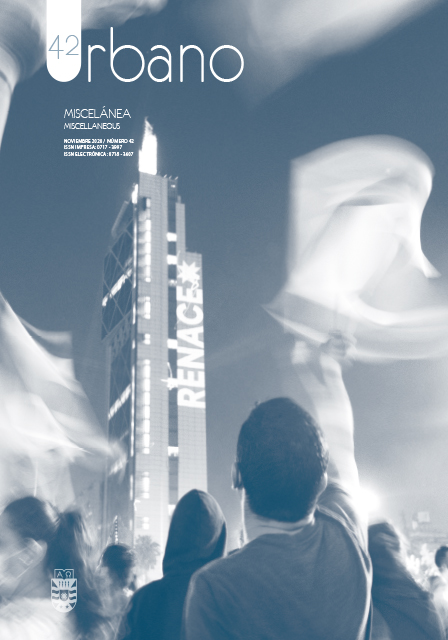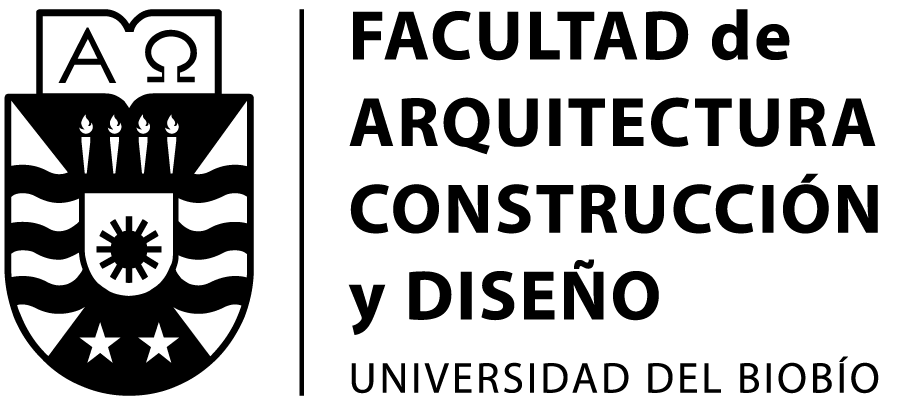Urban and economic activities in metropolitan structuring axes. The contribution of Google Places geolocated data
DOI:
https://doi.org/10.22320/07183607.2020.23.42.07Keywords:
metropolis , urban axes, urban activities, social networks, Google PlacesAbstract
Metropolitan road axes are spaces of urban centrality and opportunity to promote a greater connectivity between different parts of the urban continuum. In this sense, the functional characterization of six representative axes in Madrid, Barcelona, Paris, London, New York and Mexico City allows obtaining a current analysis of the density and diversity of economic and urban activities to identify key aspects over which to influence to improve their functional and social structure. For this, a method is proposed that adopts the geolocation data from Google Places social network as a main source of information. From the research, important similarities in the functional character of the axes are deduced, among other the predominance of activities related to services and shopping or the greater diversity of economic and urban activities in more central spaces. But differences are also identified, such as the specialization of certain activities characteristic in each metropolitan axis or the differential relationship between population density and the number of activities both in terms of density and linear quantification. All in all, the method proposed opens new possibilities for the strategic planning of economic and urban activities in metropolitan areas.
Downloads
References
Agencia de Ecología Urbana de Barcelona. AEUB (2015). Certificación del Urbanismo Ecológico. Recuperado de http://www.bcnecologia.net/
Ballatore, A. y De Sabbata, S. (2020). Los Angeles as a digital place: the geographies of user-generated content. Transactions in Gis, 24(4), 880-902. DOI: https://doi.org/10.1111/tgis.12600
Barreneche, C. (2012). Una página Web para cada lugar en el mundo: Google, codificación y comodificación del espacio. Actas del II Congreso Internacional sobre Imagen, Cultura y Tecnología (pp. 231–241). Madrid, España.
Burgess, E. W. (1984). The growth of the city: an introduction to a research project. En Park, R. E., Burgess, E. W. y McKenzie, R. D. (Eds.), The City. Suggestions for investigation of human behavior in the urban environment (pp. 47–62). Chicago: The University of Chicago Press.
Carpio-Pinedo, J. y Gutiérrez, J. (2020). Consumption and symbolic capital in the metropolitan space: Integrating ‘old’ retail data sources with social big data. Cities, 106, 102859. DOI: https://doi.org/10.1016/j.cities.2020.102859
Da Cruz, N. F., Oh, D. Y. y Choumar, N. B. (2020). The metropolitan scale. Cities, 100, 102644. DOI: https://doi.org/10.1016/j.cities.2020.102644
De Souza, M. V. y Bustos, A. (2017). El comercio informal de calle en las comunas Santiago y Concepción. Revista Urbano, 20(35), 58–73. DOI: https://doi.org/10.22320/07183607.2017.20.35.05
Folch, D. C., Spielman, S. E. y Manduca, R. (2018). Fast Food Data: Where User-Generated Content Works and Where It Does Not. Geographical Analysis, 50(2), 125–140. DOI: https://doi.org/10.1111/gean.12149
Foursquare INC. (2018). Foursquare Venue Categories. Recuperado de https://developer.foursquare.com/docs/resources/categories
Gehl, J. (2011). Life between buildings: using public space. Washington: Island Press.
Gehl, J. y Svarre, B. (2013). How to study public life. Washington: Island Press.
Google Developers (2019). Place Types. Recuperado de https://developers.google.com/places/supported_types
Cullen, G. (1961). The Concise Townscape. Architectural Press.
Hildenbrand, A. (2017). El abandono de la cuestión metropolitana en España. La necesidad de dar un nuevo impulso para su replanteamiento. Revista Iberoamericana de Urbanismo, (13), 25–46. Recuperado de http://hdl.handle.net/2117/108615
Hillier, B. (1996). Cities as movement economies. Urban Design International, 1(1), 41–60. DOI: http://dx.doi.org/10.1057/udi.1996.5
Hillier, B. (2007). Space is the machine. A configurational theory of architecture. London: Space Syntax.
Jacobs, A. B. (1995). Great Streets. Cambridge: MIT Press.
Jacobs, J. (1961). The death and life of great American cities. New York: Vintage Books.
Keßler, C. y McKenzie, G. D. (2019). Consistency Across Geosocial Media Platforms. En Proceedings of the 15th International Conference on Location-Based Services (pp. 2013–2018). Viena, Austria. DOI: https://doi.org/10.34726/lbs2019.57
Krätke, S. (2007). Metropolisation of the European economic territory as a consequence of increasing specialisation of urban agglomerations in the knowledge economy. European Planning Studies, 15(1), 1–27. DOI: https://doi.org/10.1080/09654310601016424
Levy, R. M. (1998). The visualisation of the street. Computer modelling and urban design. En N. R. Fyfe (Ed.), Images of the street: planning, identity, and ontrol in public space (pp. 58-74). Nueva York: Routledge.
Lynch, K. (1960). The image of the city. Massachusetts: MIT Press.
Lynch, K. (1984). Good city form. Cambridge: MIT Press.
Martí, P., Serrano-Estrada, L. y Nolasco-Cirugeda, A. (2019). Social Media data: Challenges, opportunities and limitations in urban studies. Computers, Environment and Urban Systems, 74, 161–174. DOI: https://doi.org/10.1016/j.compenvurbsys.2018.11.001
Mehta, V. (2014). The Street: A Quintessential Social Public Space. New York: Rouledge.
Mehta, V. (2019). Streets and social life in cities: a taxonomy of sociability. Urban Design International, 24(1), 16-37. DOI: https://doi.org/10.1057/s41289-018-0069-9
Morris, H., Mainelli, M. y Wardle, M. (2015). The Global Financial Centres Index 27.
Newman, O. (1972). Defensible space. People and design in the violent city. London: Architectural Press.
OECD. (2020). Stat- Metropolitan areas. Recuperado de https://stats.oecd.org/
Park, R. E. y Burgess, E. W. (1984). The City. Suggestions for investigation of human behavior in the urban environment. Personality and Individual Differences (Vol. 2). Chicago: The University of Chicago Press.
Sen, R., Quercia, D., Ruiz, C. V. y Gummadi, K. P. (2016). Scalable urban data collection from the web. En Proceedings of the 10th International Conference on Web and Social Media, ICWSM 2016 (pp. 683–686). Colonia, Alemania.
Stock, K. (2018). Mining location from social media: A systematic review. Computers, Environment and Urban Systems, 71(Mayo), 209–240. DOI: https://doi.org/10.1016/j.compenvurbsys.2018.05.007
Tasse, D. y Hong, J. I. (2014). Using social media data to understand cities. En NSC workshops on big data and urban informatics. Chicago. Recuperado de https://www.dantasse.com/docs/using_social_media_data_to_understand_cities_bduic2014.pdf
Terrazas, O. (2004). La centralidad metropolitana en la ciudad de México. En A. Rodriguez Kuri y S. Tamayo Flores-Alatorre (Eds.), Los últimos cien años. Los próximos cien... (pp. 236–265). México: Universidad Autónoma Metropolitana.
United Nations. Department of Economic and Social Affairs. Population Division (2018). The World’s Cities in 2018 - Data Booklet (ST/ESA/ SER.A/417).
Van Susteren, A. (2005). Metropolitan world atlas. Rotterdam: 010 Publishers.
Vu, H. Q., Li, G. y Law, R. (2020). Cross-Country Analysis of Tourist Activities Based on Venue-Referenced Social Media Data. Journal of Travel Research, 59(1), 90–106. DOI: https://doi.org/10.1177/0047287518820194
Yang, L. y Marmolejo Duarte, C. (2019). Identifying tourist-functional relations of urban places through Foursquare from Barcelona. GeoJournal. DOI: https://doi.org/10.1007/s10708-019-10055-9
Downloads
Published
How to Cite
Issue
Section
License
Copyright (c) 2020 Leticia Serrano-Estrada; Álvaro Bernabeu Bautista, Pablo Martí Ciriquián

This work is licensed under a Creative Commons Attribution-ShareAlike 4.0 International License.
The content of articles which are published in each edition of Habitat Sustentable, is the exclusive responsibility of the author(s) and does not necessarily represent the thinking or compromise the opinion of University of the Bio-Bio.
The author(s) conserve their copyright and guarantee to the journal, the right of first publication of their work. This will simultaneously be subject to the Creative Commons Recognition License CC BY-SA, which allows others to share-copy, transform or create new materials from this work for non-commercial purposes, as long as they recognize authorship and the first publication in this journal, and its new creations are under a license with the same terms.![]()























